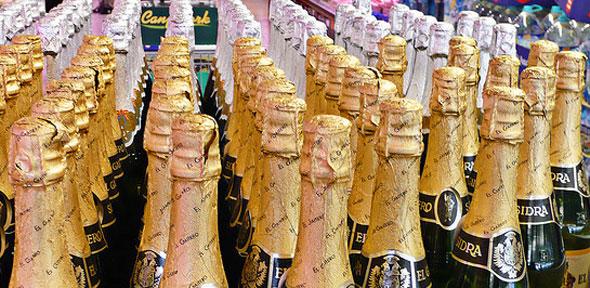
New research has found that displays at the end of supermarket aisles significantly increase purchases of the displayed alcohol – by 46% for spirits, 34% for wine and 23% for beer. The study also reveals that similar displays of carbonated drinks increase purchases by 52%.
Although it is likely that marketing research exists within the retail industry about the sales effects of end-of-aisle displays, until now there has been little scientific research on the extent of its influence on alcohol and carbonated drink purchases.
The study used data collected from a branch of a major supermarket chain in England. It was conducted by the Behaviour and Health Research Unit, a collaboration between the University of Cambridge, the University of East Anglia, and MRC Human Nutrition Research. The research is published today in the journal Social Sciences and Medicine.
The researchers used detailed information about store layout and product sales of three types of alcoholic drinks (beer, wine and spirits) and three non-alcoholic drinks (carbonated drinks, coffee and tea).
After controlling for price, price promotion and the number of display locations for each product, they found that displaying an item at the end of the aisle increased the sales of that item by 23.2% for beer, 33.6% for wine, and 46.1% for spirits. For non-alcoholic products, in the increase in sales was up 51.7% for carbonated drinks, 73.5% for coffee, and 113.8% for tea.
“Our study shows, for the first time, that these types of displays dramatically influence people’s decisions to purchase alcohol and carbonated drinks,” said lead author Dr Ryota Nakamura from the Behaviour and Health Research Unit and the University of East Anglia. “Prohibiting or limiting this marketing tactic for less healthy options, or utilising this for healthier ones, holds the promising possibility of encouraging healthier lifestyle choices.”
Not surprisingly, a lower price was also associated with increased sales for all of the products, with the biggest impact on alcohol. For every 1% decrease in the price (per volume), there was approximately a 5% increase in sales volume – 5.6% for beer, 5.2% for wine and 5% for spirits. Lower prices had less of an impact on sales of non-alcoholic beverages: a 1% decrease in price was associated with a 2.3% increase for carbonated drinks, 2% for coffee, and 1.8% for tea.
Professor Theresa Marteau, Director of the Behaviour and Health Research Unit at the University of Cambridge and co-author of the study, said: “Although we often assume price is the biggest factor in purchase choices, end-of-aisle displays may play a far greater role. It would therefore make sense that any intervention to curb the consumption of alcohol and sugar-sweetened drinks takes this into consideration.”
Restricting displays – which increase sales of displayed drinks by up to 46% for alcohol and by 52% for carbonated drinks - could curb consumption without affecting price or availability.
This work is licensed under a Creative Commons Licence. If you use this content on your site please link back to this page.
